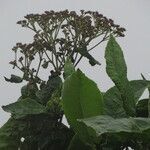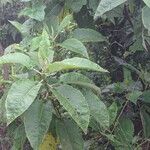Leaves mostly rather closely set at ends of branches, rarely drought deciduous; petiole 1–8.5 cm long, sometimes bearing 1–2 leaf-like, elliptic, ovate or obovate pseudostipules 1–3.5(5) × 0.5–1.8 cm at the base; lamina membranous, 5–30(37.5) × (1.5)2–11(15) cm, elliptic to broadly ovate or lanceolate, sometimes obovate or oblanceolate, base cuneate to sub-rounded, narrowing to the petiole and subequal-to unequal-sided, apex usually ± acuminate, entire or slightly repand-sinuate, markedly discolorous, at first nearly snow-white tomentose on both surfaces, soon glabrescent and dark shiny above, persistently tomentellous and rarely with 1–2 short prickles beneath, with (7)9–12(14) pairs of lateral nerves.
Shrub, small tree, up to 6 m high; most parts whitish stellate-hairy. Prickles 0-several, 1-5 mm long, stout, ± straight, flat, triangular. Stems hairy to glabrescent. Leaves elliptic to oblanceolate, velvety white-tomentose both sides, above soon ± glabrous, shiny dark green. Inflorescence up to 100 mm long, hairy to glabrescent; peduncle up to 45 mm long; pedicels 5-20 mm long. Calyx 4-6 mm long, lobes up to 4 mm long, ± triangular. Corolla rotate, up to 16 mm in diam., lobes lanceolate, 5-7 mm long, mauve to purple. Flowering time Oct.-Apr. Fruit many, globose, 5-10 mm in diam., smooth, shiny, red to purple. Seeds many, reniform, flat, up to 4 mm long, white.
A shrub or small tree. It grows 3-5 m tall. The bark is pale grey to brown. The small branches are covered with thick white woolly hairs. There are also short straight prickles about 5 mm long. The leaves are oval and alternate. They are 23 cm long by 9 cm wide. They are dark green above and have dense white woolly hairs underneath. The leaf stalk is 2.5 cm long. The flowers are white to violet. They are 10 mm across. The occur in heads made up of many flowers and these are at the ends of branches. The fruit are almost round and fleshy. They are 10 mm across. They are bright red when ripe. These are in dense heads up to 20 cm across. The fruit are edible.
Shrub or small tree, up to 4 m high; much-branched stems and peduncles white-woolly. Spines straight. Leaves petiolate; blade elliptic to obovate, 70-300 x 40-90 mm, apex acute, base cuneate, margins entire, upper surface dark green, lower densely white-woolly; petioles up to 25 mm long. Flowers: in terminal, stout, branched heads; corolla ± 10 mm in diameter, white to purple; Nov.-Apr. Fruit an orange to red berry, up to 10 mm in diameter.
Short-lived, softly woody under shrub, shrub or sometimes a small tree, up to 5(8) m high; sympodia plurifoliate; hairs stellate, white (ageing greyish or yellowish in herbaria), very fine (c. 0.1–0.2 mm across), floccose, ± sessile, regular, with many short rays; prickles 1–5 mm long, straight or slightly curved, laterally ± compressed, often hairy from the base to above the middle.
Corolla pale blue to lilac or violet-purple, rarely white, the midvein of each lobe green, stelliform; limb (8)12–15(18) mm across; lobes (3)5–7(8) × (1.3)2–3(3.5) mm, lanceolate to oblong, acute to acuminate, tomentose outside, with a few stellate hairs on the midvein and near the apex inside, widely spreading to reflexed.
Calyx 4–6 mm long, campanulate or cyathiform, in fruit saucer-shaped, tomentose, unarmed, somewhat accrescent; lobes 1–4 × 1–2 mm, lanceolate-triangular to deltate or ovate-triangular, occasionally ovate-cuneate, obtuse or acute, sometimes ± acuminate.
Ovary c. 1 mm in diameter, ± globose, glabrous except for few, minute, sub-apical glands; style 5–7(8) mm long, exceeding the stamens, straight or slightly curved at the apex, glabrous or with a few minute glands from the base to above the middle.
Cymes towards the ends of the branches, becoming lateral, 4.5–10 cm long, corymbiform to ± paniculiform, dense, many-flowered, densely whitish tomentose, sometimes ± glabrescent in fruit; peduncle 1.5–4(5.5) cm long, sometimes ± armed.
Tree, up to 4 m high. Branches spiny. Spines short, conical and broad-based. Leaves entire, discolorous, glabrous above, white tomentose beneath. Inflorescence terminal. Corolla 10 mm in diameter. Fruits red. Flowers violet-purple.
Shrub or small tree to 3 m; white-woolly on young parts; spines to 4 mm long, stout. Leaves elliptic, white-woolly beneath, to 15 cm long. Flowers crowded in terminal corymbs, mauve to purple, 6 mm diam. Berries red, to 8 mm diam.
Seeds numerous, straw-coloured to ± whitish, 2.5–3.8 × 2–3 mm, compressed, obliquely reniform, obovate, elliptic or suborbicular in outline, shallowly reticulate.
Flowers faintly scented, (4)5(6)-merous, ± nodding; pedicels 0.5–2 cm long, slender, in fruit elongated to 2.5 cm, ± thickened, erect.
Stamen filaments 0.2–0.6(1) mm long; anthers 2–4 mm long, linear or lanceolate-elliptic in outline, not very incurved.
Branches whitish tomentose, with scattered prickles, sometimes quite unarmed on late growth, sometimes ± glabrescent.
Fruits often numerous, shiny red when ripe, finally deep red, (5)6–8(10) mm in diameter, ± globose, appearing edible.
White tomentum on all parts, except the surfaces of the leaves
A shrub or tree up to 25 ft. high
Flowers violet-purple.



